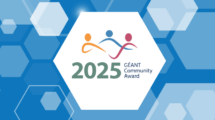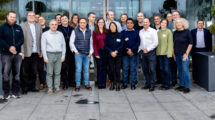This interview is part of a series highlighting the objectives, roles and mission of GÉANT Community Programme’s special interest groups and task forces.
Gert, Niels and Robert, you are Chairs of the Task Force on Distributed Ledger Technologies (TF-DLT). We are curious to know how each of you sees the impact and value of the TF to your respective local communities as well as your own daily work.
Gert: A task force is a great opportunity to challenge and to be challenged to share experiences, use cases and discoveries, to try out new ideas and to innovate. However, always in relation with the day to day operational reality and budgets. Therefore, my philosophy has always been that you must have your eyes in the sky (and that even the sky is sometimes not the limit) and to have also your feet in the muddy and sandy ground. In a task force this can be realized by exchanging ideas and thinking about new technology but at the same time sharing experiences, operational reality examples, use cases and budget/resources shortage so that can be observed what can, will, would and might (not) be possible.
Niels: For NRENs it is critical to act locally, but think globally. Many of the things we do need a local approach, but must be based on best practices that have been established in a broader, international context, so that we ensure usability and interoperability beyond our national borders. A task force like TF-DLT helps us to share, learn and discuss our work on a pan-European level.
Robert: As I am responsible for blockchain technologies in general at SWITCH, it is important for us to know on which topics other European countries are focusing on. As we work in different fields, it provides important knowledge on DLT and related topics when we exchange our information. Very informative are specifically the invited presentations of community members related to DLT that are regularly held during our sessions.
As you mentioned, the TF brings together experts from the NRENs and universities to share experience and ideas on their NRENs or universities are dealing with DLT and self-sovereign identity (SSI). How do you see the NRENs embracing new identity models given the existing operational infrastructures?
Gert: On the GÉANT Community website our mission is clearly defined as “to explore the usage of DLT as well as SSI in the context of the research and the education community”. This is a wide area as blockchain is only one type of distributed ledger technology next to directed acyclic graphs (DAG), hashgraph, holochain, sharding, and so on. Moreover, many people think about blockchain as in Bitcoin/Blockchain whereas a lot of different blockchain technologies (such as zero-knowledge proofs versus PKI based technology, the so-called attribute-based credentials) do co-exist making the area only wider. The same holds true for new identity models and standards such as ISO 29003, eIDAS and ESSIF. Please note that in this wide and extremely interesting technology playground we should keep focus on what we want to realize with this technology and how we can create added value for our research and education community.
Niels: For SSI, there are two trends that are pushing this novel technology. Firstly, an increased awareness on public values and data sovereignty. A technology like SSI may provide significant improvements in this area. Yet at the same time we as a community already have a well-established, trusted, federated AAI system with the national identity federations and eduGAIN. How the two ecosystems will relate is being discussed and tested by several NRENs as we speak. SSI however goes beyond just identity. Some NRENs are therefor also involved in exploring the opportunities of SSI in the context of student mobility, digital diploma’s and researcher identity and access.
Second, we have the upcoming EU Digital Identity legislation. There is I think no doubt it will have an impact on NRENs and institutions. But to what extent is currently unclear and will not only depend on the technology, but much more even on the policies that will surround this new ecosystem. We see NRENs and institutions working with governments and industry partners in several projects, on national and pan European level, to make sure we are involved and may influence this new system.
Robert: Distributed ledger use-cases are currently at an early stage when it comes to use-cases outside of the decentralized finance (DeFi) world. Working together with other experts in this field, we can elaborate an idea where those use-cases are heading to. At such early stages, a lack of proper standardization for those use-cases makes it important to synchronize across borders and industries.
Considering the very innovative topics that the TF covers, should we bring in and involve in the conversation NRENs where identity federations are less mature?
Gert: Although the TF covers very innovative topics, collaboration within the community is key. Ultimately the goal is to use the innovation in the day-to-day operations. Therefore, we need the involvement of all NRENs. However, as too many cooks spoil the broth, it is important to make the necessary choices within the broad area of DLT and to provide use cases to demonstrate the potential value within the real world. Being a mature identity provider, such as Belgium with our eID and itsme can also be a delaying factor. This is referred to as the law of the handicap of a head start, or the first-mover disadvantage (Wet van de remmende voorsprong). The term was coined in 1937 by Jan Romein, a Dutch journalist and historian, in his essay “The dialectics of progress” (“De dialectiek van de vooruitgang”). It is a theory that suggests that an initial head start in a given area may result in a handicap in the long term. As such a proven system can be an obstacle to take the next leap. In my humble opinion, we can also observe this within our federated identity. We should not be afraid to take the leap towards government-issued electronic identities (e-identity) to create a universal academic electronic identify guaranteeing life-long learning and passing seamlessly from one organisation to another. Ergo, catalysts to innovation for sure, but in the end we should obtain a chemical compound that proves useful and beneficial.
Niels: While indeed the topics in the TF are very innovative when it comes to technology, some of the core elements needed to make the technology usable in the real world are similar to what we already have with federated identity. For example, a trust framework is one of the most important features and this is where NRENs and federations will likely remain to play an important role. Discussing and deciding how that role gets shaped must be a community effort, I think.
Robert: As a task force in the innovative field of DLT it is important to spread the ideas from time to time also to communities that are not that closely involved in the topic. In addition, DLT use cases are not limited to identity federation. There is another GÉANT group focusing more specific on SSI while this TF should focus on DLT and blockchain use cases in a more general way. However, it is correct that the current discussed use cases are mostly identity related.
We know that a most common theme discussed during the last year is the European Blockchain Service Infrastructure (EBSI). How do you feel that this will influence the European NREN landscape?
Gert: According to me, EBSI provides an opportunity to combine technology, use cases and operational nodes for the benefit of the entire community. The stage of testing and preproduction nodes and use cases is being wrapped. A large European organisation such as GÉANT can grasp the opportunity to bring this network of maintaining ledgers of information in a DLT by trustless blockchain nodes to the level of production in a European setting where certain NRENs can focus on hosting, governance, use case support, the trust model, strong identity authentication, security and privacy. In February 2020, BELNET was the first operator to launch an EBSI node and last year this network proved its value for our universities (confer university-pilot-proves-value-a-european-blockchain). Lack of resources and budget forces us to throw in the towel. So what is really needed in this respect is a large European player capable of coordination, collaboration and commitment on the one hand and co-creation with (inter)national partners and the entire R&E community on the other.
Niels: The EBSI work has been a very influential as it was one of the first to showcase real use cases on how distributed ledgers can be applied to our sector. At the same time, our sector should probably prepare for a scenario where multiple SSI implementations will co-exist. Some will be using blockchains like EBSI, some may have other ways to create a trust framework. We will likely have to interact with multiple of these SSI platforms and therefore we should push for interoperability and the use of open standards.
Robert: EBSI has a very nice approach as a blockchain infrastructure in the European commission level. Especially as it moved to a more EVM (Ethereum Virtual Machine) based approach. However, decentralized public permissioned blockchains like EBSI should also allow interaction with outside countries of the European commission. Switzerland/UK are part of Europe but currently excluded from EBSI which makes it hard to contribute as well as applying use-cases on EBSI. Validator nodes could still be controlled by European commission countries while allowing outside countries to interact with EBSI on a transaction/smart contract level.
The world of DLT and SSI (self-sovereign identity) is a fast-moving environment, and they are often considered as the same technology. Can you tell us about other areas of work and applications that the TF are planning on further exploring in the near future?
Gert: To create added value for our research and education community while bringing the different technologies of DLT and SSI together, I would like to focus on the outcome of verifiable credentials (VC). VC can present the same information that can be found on physical credentials but in a digital and selective manner. For instance, when you have to show your identity card to prove that you are over 18 years old (a question that I do not get anymore lately …) you have to hand over your card physically and all of the information elements on that card are disclosed. With a VC one can proof that one is over 18 years old remotely (without having to hand over anything physically) and without disclosing any information on the card. Even the birth date is not disclosed. This is known as selective disclosure.
Being digitally signed VC are tamper-resistant and instantaneously verifiable even online. They can be issued by anyone (Issuer), about anything from the Holder and can be sent to everyone and verified immediately (Verifier). They are like a stone perfectly cut in two (symbolon). Both parts match and only these two unique parts will match. One part of the symbolon information is signed by the Issuer (for instance that the Holder has a diploma or a micro credential) and is issued to the Holder who countersigns. This will then be sent by the Holder to the Verifier. The other part of the symbolon information is sent via the blockchain by the Issuer. For instance, Eva proofs by means of eID her identity and links this to her electronic wallet. She has done her first two years of bachelor of pedagogical sciences in Leuven. As she wants to go on Erasmus to Padua KULeuven can sign and issue her claim. Eva can countersign this and send it to Padua. In Padua they can verify this information instantaneously by putting both parts of the symbolon together and disclosing as such the required information.
Niels: It is I think good to note that an SSI implementation may be built on top of a distributed ledger, but it is not a mandatory requirement. It depends on the use case if using a ledger adds value. This also goes for SSI as a whole: we as a community need to figure out where using SSI makes sense and where it does not. In some use cases a more traditional approach may be just as effective, where in others the unique features of SSI make it a logical choice. It is these kinds of discussions we should have more I think within our community.
Robert: Very good question. Currently, the TF DLT mainly focuses on identity and SSI related topics. Other areas could include decentralized, autonomous organizations (DAOs), its voting models for decentralized governance or systems such as (or similar to) advanced science blockchains like Bloxberg. It is also important to notice that the second largest public blockchain Ethereum successfully moved from Proof of Work to Proof of Stake in the last months. That makes Ethereum based solutions much more sustainable and therefore suitable for use-cases we could focus on in the TF DLT. Further, it could be explored how blockchain based name registries (such as ENS) could influence or be combined with the traditional, centralized national domain name registry models.
Stay updated on TF-DLT activities, achievements and future meetings on the group’s wiki page. More on the GÉANT Community Programme, its mission and tasks can be found here.
Robert Ott, SWITCH – Robert is a blockchain enthusiast and he is responsible for blockchain related projects at SWITCH. Prior to that, he worked for various start-up companies in the field of innovation in Switzerland and the US. He completed a Master’s degree in Computer Science at the University of Wollongong in Australia.
Niels van Dijk, SURF – Niels is a Technical Product Manager working in Trust & Identity Development team at SURF. In this role he is responsible for development and innovation of SURF’s authentication and authorization services. He is also an active member of the REFEDs and eduGAIN community. Before coming to SURF, Niels build some ten years of experience in designing and developing innovative solutions in the field of internet based databases and GIS (Geographical Information Systems), mainly for the Utilities and Emergency Response sector. When not at work, he enjoys the company of his wife and two boys, sings in a choir, and likes to tinker with all kinds of hardware.
Gert De Braekeleer, Belnet – Gert is a product manager in the innovation team working at Belnet. In this role he is trying to make the ball rolling for development and co-creation of Belnet’s services. The other part of his time he is taking up both the roles of (security) incident, problem and change manager for the ongoing operations as well as the one of business continuity manager. Gert is also coordinating a spending review for cyber security for all federal governmental organisations and the research and education community in Belgium. As such he is involved to guarantee for the GOV and R&E community dedicated connectivity and internet for the exchange of information. Before coming to Belnet, Gert has built thirty years of experience in designing and developing innovative solutions in the field of artificial intelligence, computational linguistics, localization (L10N) and Internationalization (I18N). From 2015 onwards he became gradually more and more involved in Blockchain and Bitcoin by working in and on the Dark Web, TOR, ransomware, and training the cyber squad teams in “following the cyber money” and to find out who was behind the anonymous accounts. When not at work, he enjoys the company of his wife, his daughter and two boys. Moreover, he likes to read and travel, to go to cultural shows and performances and is involved in many non-profit organizations. Last but not least he plays in the local chess club.







